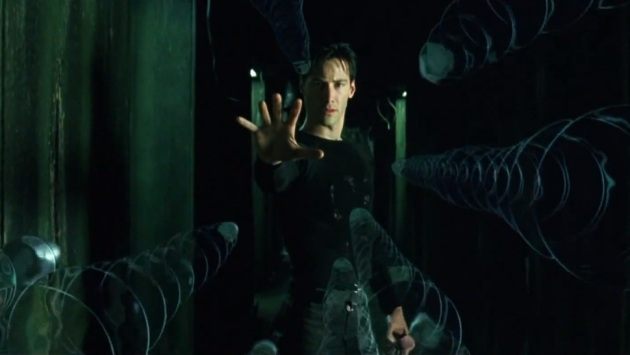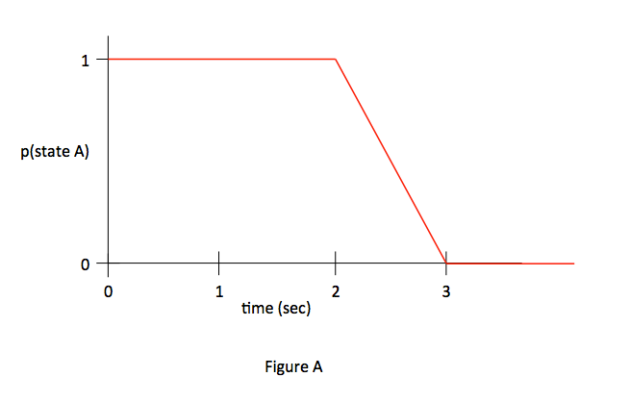Lurking amidst the mass chaos of information that exists in our reality is a little gem of a concept called the Quantum Zeno Effect. It is partially named after ancient Greek philosopher Zeno of Elea, who dreamed up a number of paradoxes about the fluidity of motion and change. For example, the “Arrow Paradox” explores the idea that if you break down time into “instants” of zero duration, motion cannot be observed. Thus, since time is composed of a set of instants, motion doesn’t truly exist. We might consider Zeno to have been far ahead of his time as he appeared to be thinking about discrete systems and challenging the continuity of space and time a couple thousand years before Alan Turing resurrected the idea in relation to quantum mechanics: “It is easy to show using standard theory that if a system starts in an eigenstate of some observable, and measurements are made of that observable N times a second, then, even if the state is not a stationary one, the probability that the system will be in the same state after, say, one second, tends to one as N tends to infinity; that is, that continual observations will prevent motion …”. The term “Quantum Zeno Effect” was first used by physicists George Sudarshan and Baidyanath Misra in 1977 to describe just such a system – one that does not change state because it is continuously observed.
The challenge with this theory has been in devising experiments that can verify or falsify it. However, technology has caught up to philosophy and, over the last 25 years, a number of experiments have been performed which seem to validate the effect. In 2001, for example, physicist Mark Raizen and a team at the University of Texas showed that the effect is indeed real and the transition of states in a system can be either slowed down or sped up simply by taking measurements of the system.
I have enjoyed making a hobby of fully explaining quantum mechanics anomalies with the programmed reality theory. Admittedly, I don’t always fully grasp some of the deep complexities and nuances of the issues that I am tackling, due partly to the fact that I have a full time job that has naught to do with this stuff, and partly to the fact that my math skills are a bit rusty, but thus far, it doesn’t seem to make a difference. The more I dig in to each issue, the more I find things that simply support the idea that we live in a digital (and programmed) reality.
The quantum Zeno effect might not be observed in every case. It only works for non-memoryless processes. Exponential decay, for instance, is an example of a memoryless system. Frequent observation of a particle undergoing radioactive decay would not affect the result. [As an aside, I find it very interesting that a “memoryless system” invokes the idea of a programmatic construct. Perhaps with good reason…]
A system with memory, or “state”, however, is, in theory, subject to the quantum Zeno effect. It will manifest itself by appearing to reset the experiment clock every time an observation is made of the state of the system. The system under test will have a characteristic set of changes that vary over time. In the case of the University of Texas experiment, trapped ions tended to remain in their initial state for a brief interval or so before beginning to change state via quantum tunneling, according to some probability function. For the sake of developing a clear illustration, let’s imagine a process whereby a particle remains in its initial quantum state (let’s call it State A) for 2 seconds before probabilistically decaying to its final state (B) according to a linear function over the next second. Figure A shows the probability of finding the particle in State A as a function of time. For the first 2 seconds, of course, it has a 0% probability of changing state, and between 2 and 3 seconds it has an equal probability of moving to state B at any point in time. A system with this behavior, left on its own and measured at any point after 3 seconds, will be in State B.
What happens, however, when you make a measurement of that system, to check and see if it changed state, at t=1 second? Per the quantum Zeno effect, the experiment clock will effectively be reset and now the system will stay in State A from t=1 to t=3 and then move to state B at some point between t=3 and t=4. If you make another measurement of the system at t=1, the clock will again reset, delaying the behavior by another second. In fact, if you continue to measure the state of the system every second, it will never change state. Note that this has absolutely nothing to do with the physical impact of the measurement itself; a 100% non-intrusive observation will have exactly the same result.
Also note that, it isn’t that the clock doesn’t reset for a memoryless system, but rather, that it doesn’t matter because you cannot observe any difference. One may argue that if you make observations at the Planck frequency (one per jiffy), even a memoryless sytem might never change state. This actually approaches the true nature of Zeno’s arguments, but that is a topic for another essay, one that is much more philosophical than falsifiable. In fact, “Quantum Zeno Effect” is a misnomer. The non-memoryless system described above really has little to do with the ad infinitum inspection of Zeno’s paradoxes, but we are stuck with the name. And I digress.
So why would this happen?
It appears to be related in some way to the observer effect and to entanglement:
- Observer Effect – Once observed, the state of a system changes.
- Entanglement – Once observed, the states of multiple particles (or, rather, the state of a system of multiple particles) are forever connected.
- Quantum Zeno – Once observed, the state of a system is reset.
What is common to all three of these apparent quantum anomalies is the coupling of the act of observation with the concept of a state. For the purposes of this discussion, it will be useful to invoke the computational concept of a finite state machine, which is a system that changes state according to a set of logic rules and some input criteria.
I have explained the Observer effect and Entanglement as logical necessities of an efficient programmed reality system. What about Quantum Zeno? Why would it not be just as efficient to start the clock on a process and let it run, independent of observation?
A clue to the answer is that the act of observation appears to create something.
In the Observer effect, it creates the collapse of the probability wave functions and the establishment of definitive properties of certain aspects of the system under observation (e.g. position). This is not so much a matter of efficiency as it is of necessity, because without probability, free will doesn’t exist and without free will, we can’t learn, and if the purpose of our system is to grow and evolve, then by necessity, observation must collapse probability.
In Entanglement, the act of observation may create the initiation of a state machine, which subsequently determines the behavior of the particles under test. Those particles are just data, as I have shown, and the data elements are part of the same variable space of the state machine. They both get updated simultaneously, regardless of the “virtual” distance between them.
So, in Quantum Zeno, the system under test is in probability space. The act of observation “collapses” this initial probability function and kicks off the mathematical process by which futures states are determined based on the programmed probability function. But that is now a second level of probability function; call it probability function 2. Observing this system a second time now must collapse the probability wave function 2. But to do so means that the system would now have to calculate a modified probability function 3 going forward – one that takes into account the fact that some aspect of the state machine has already been determined (e.g. the system has or hasn’t started its decay). For non-memoryless systems, this could be an arbitrarily complex function (3) since it may take a different shape for every time at which the observation occurs. A third measurement complicates the function even further because even more states are ruled out.
On the other hand, it would be more efficient to simply reset the probability function each time an observation is made, due to the efficiency of the reality system.
The only drawback to this algorithm is the fact that smart scientists are starting to notice these little anomalies, although the assumption here is that the reality system “cares.” It may not. Or perhaps that is why most natural processes are exponential, or memoryless – it is a further efficiency of the system. Man-made experiments, however, don’t follow the natural process and may be designed to be arbitrarily complex, which ironically serves to give us this tiny little glimpse into the true nature of reality.
What we are doing here is inferring deep truths about our reality that are in fundamental conflict with the standard materialist view. This will be happening more and more as time goes forward and physicists and philosophers will soon have no choice but to consider programmed reality as their ToE.








